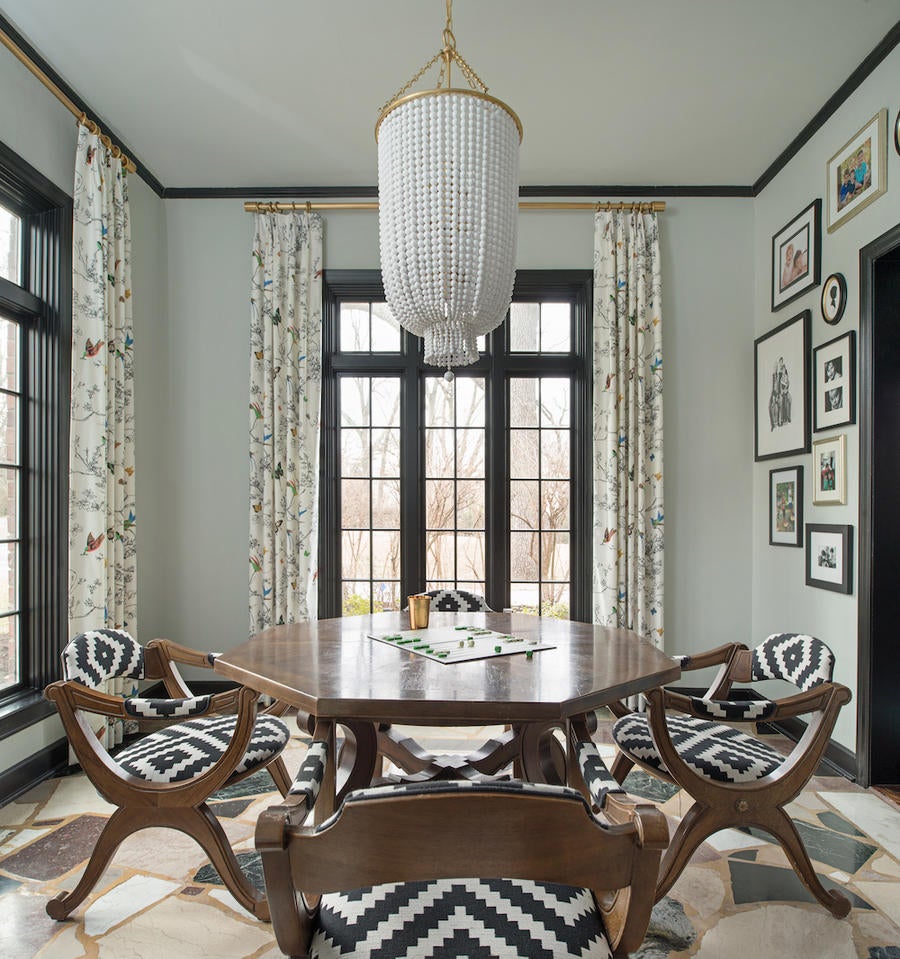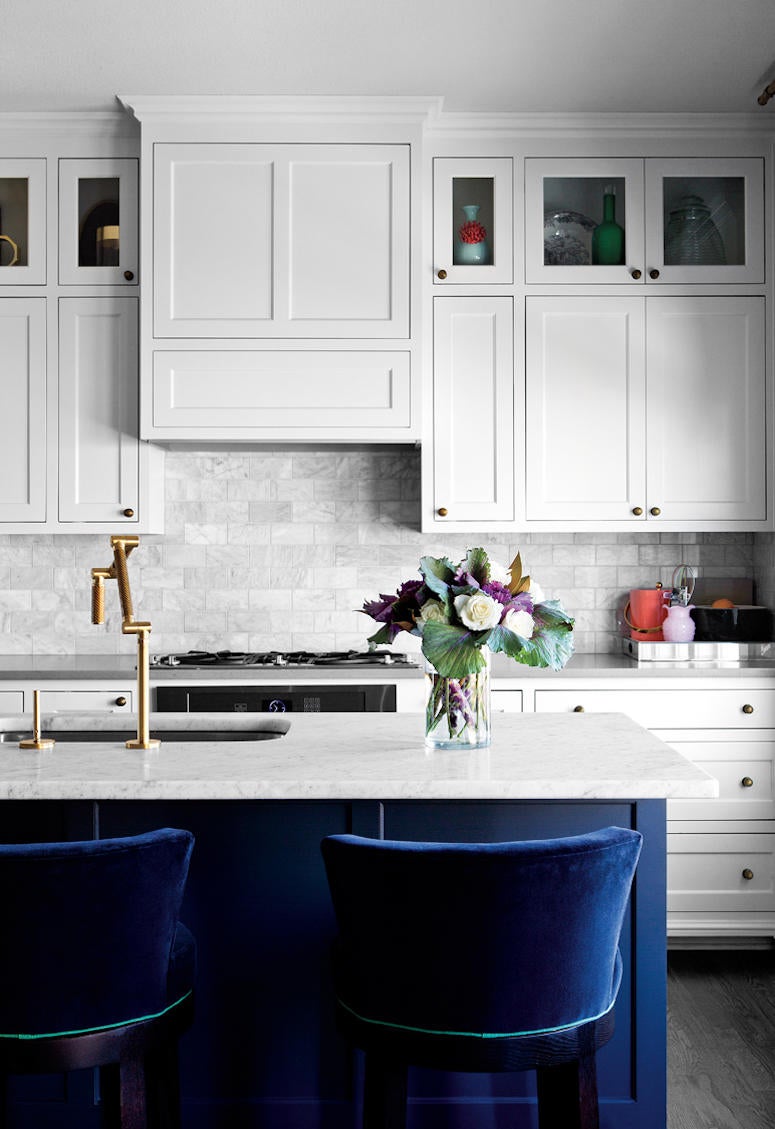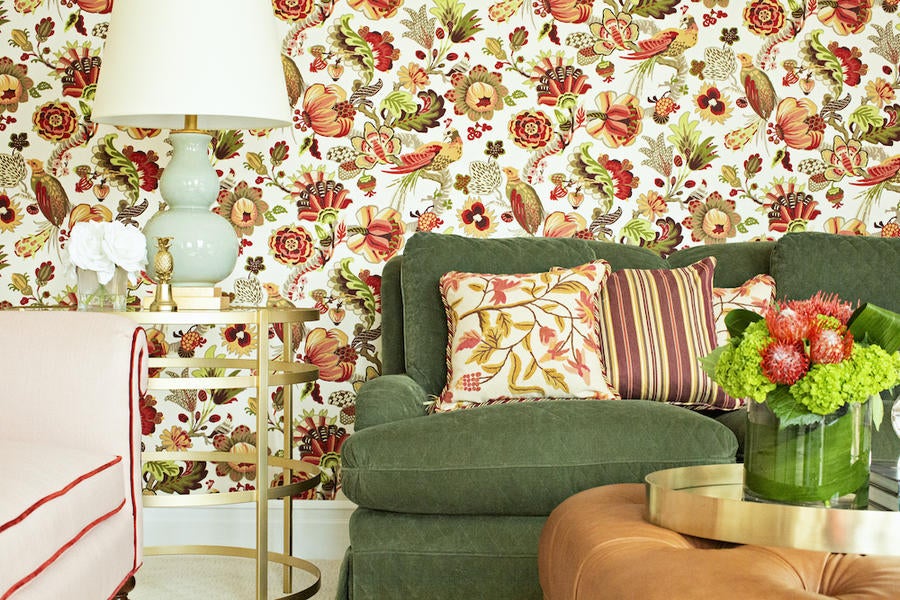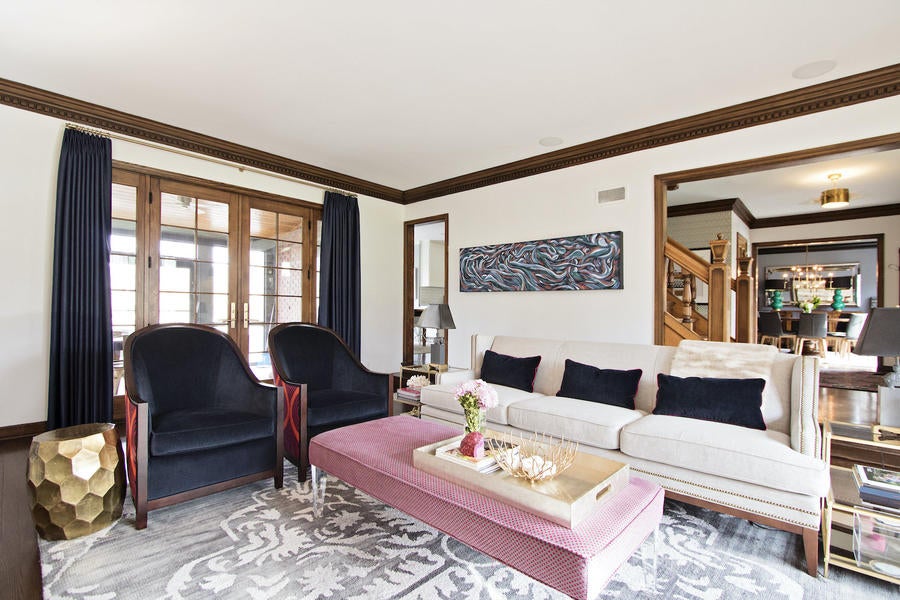The 50 States Project is a yearlong series of candid conversations with interior designers we admire, state by state. Today, we’re chatting with Sara Noble, who left a career in finance to launch her Leawood, Kansas–based design firm in 2003. She talks about the risks of not dreaming big enough, why her team is her biggest asset during the pandemic, and how pitching herself relentlessly netted her two product lines and a book deal.
I grew up in the Kansas City area, not too far from Leawood, but I haven’t been back in a long time. What is the housing market like today?
We had a strong new construction market going prior to [the pandemic]—although construction is still open here in Kansas and projects are still continuing at the moment, I think there’s a little hesitation about whether it will continue as strongly. As you go out south, you’ll find that a lot of houses are large—it’s a cheaper cost of living to be in Kansas, so you can build a large house for a reasonable price. More in town, there’s a resurgence of remodeling the smaller, older homes in towns like Fairway or Prairie Village to make them more adaptable for today’s family.
How are clients finding you?
The majority come by word of mouth—it’s always been that way for me. I started 18 years ago, when I sold my first jobs at a Junior League holiday mart. I got a booth, sold five jobs, and it really grew from there. Last year was the first time I ever paid for advertising, and that was really due to a new focus on growing the business; we’ve added staff, so I’m making calculated decisions to reach my ideal clients. We’ve also had some really good luck with Instagram. We don’t have a huge following yet, but I do think we offer a fresh twist—and that’s reflected in our Instagram, so the clients we get from there are ideal clients for us because they are already open to what we’re trying to do.
How did you come to have that Junior League booth?
I actually have a finance degree, which has served me really well. I look back and I feel like it all happened the way it was supposed to, but none of it according to plan. I got the finance degree but hated my finance job. My mom used to drive me to antique stores when I was a kid, so I was always interested in antiques and design and color. Friends started asking me to do their homes—you know how these things are. It’s like, “Oh, I’ve got a knack for this.”
My mom and I [originally] thought that our dream was to be the next Nell Hill’s, which is a big local home decor retailer in Kansas City. So, 18 years ago, we went and bought product in Chicago and applied to get into the Junior League holiday mart—at the time, it was kind of difficult to get in, but we did. I think we paid $1,000 for a 5-by-10-foot booth and worked this show, and realized quickly that was not the dream. That was not our knack. But at the show, I sold five design jobs, and my firm grew from there.
At the time, I had very young children, so it was a very part-time gig for me. For a while, I worked part-time as a financial analyst, and then on my lunch break I would race to the local showroom and gather my fabrics and materials and then do design work at night and client meetings on the weekends. I was lucky enough that it didn’t take long before I got out of the finance world and started doing this more full-time. But, again, I still had young children, so it was part-time for many years for me. It’s been a full-time career probably for the last nine.
What was the moment where you shifted to thinking about the firm as a career?
The biggest detriment to my business was I didn’t dream big enough early enough. It took me a while to believe in myself, to believe that I’m really good at this, and to say: “OK, I’m going to make a career out of it.” It started to take off, and nine years ago I became busy enough that I could add more staff—that’s when it really started to become a business. Then I got divorced seven years ago, so it was really fortunate that I [was established] at that point. And then in the last three years, we’ve really enjoyed success, and I have a vision for the company that I’ve never had before.

What got you to that point where you thought, ‘I’m going to make big plans for the future’?
This business is hard. I work really hard to make a living. It finally just became clear to me that I’m good enough and smart enough and I want to make this a career—and if I want to have financial stability and provide that for my staff, I need to focus on the business.
How did you build your team?
I have had my accounting manager for 17 years—she’s worked 10 hours a week for me this entire time. So she was the first, and for a long time it was just the two of us. It became clear that I needed to grow, which started with back-office help. I added my senior designer, Jessica Gordon, seven years ago. I knew her design style and personality—our kids went to preschool together—so I knew we would be a good fit. She doesn’t want to own her own company, but treats mine as if it was hers.
Along the way, I’ve had a ton of bumps in the road and have learned from all of them. I mean, we don’t hire and fire all that much, but we’ve had a couple instances where I’ve tried to get part-time help and it’s really a full-time job—or I need somebody that can dedicate effort and make it a priority, which is sometimes hard when it’s more of a side gig for that person. We just hired a new full-time office manager on January 1 and a full-time designer on February 1. And then, in between, I had added another designer and a part-time expediter. This core group is by far my biggest asset right now. If this coronavirus has taught me anything so far, it’s that I have an amazing team and that I have to do anything I can to keep them. Because that’s really the only thing I need to restart. I want this team.
How has the coronavirus crisis slowed you down so far? You said construction is still going, but has other work slowed or stopped?
Yes, we had about half of our projects go on hold, which is concerning. I mean, we are still doing construction in Kansas, so those projects have continued—and maybe even at a faster pace—so that’s fantastic, but the other ones are on hold.
The biggest concern for me as a business owner is watching our leads come in. We would usually get a handful a week, but we have had three and a half weeks of silence. I’m not used to that, so there’s this immediate alarm. At the same time, we have—this word is completely overused—we have pivoted and adjusted to what’s going on, and I think [consumers] are adjusting too.
What did that pivot look like for you?
I started doing an Instagram Live series called “I Hate My House.” You send me a picture of what you don’t like and then I go live and talk about it—and usually sidetrack into other silly stuff too. And we actually did get a job out of doing that! It was really exciting. And because we have done out-of-town projects, we already had a way to work virtually. We adapted that and started offering a one-room virtual package. We’ve sold three of those in the past week—and two of the three are ideal clients for us. I think there’s a real possibility that we’ll come back and do more work later for [some of them].

Are those virtual jobs local or far away?
We would love to do far away, but so far it’s local.
What does that virtual offering look like? Did you rework some of your normal business practices?
We do it through Zoom—which is new to me; I hadn’t used it before the coronavirus. We have the client take us through their house with their phone. They’ll also shoot us still pictures so we have those to work from, and they take their measurements. There’s certainly a little bit more work involved for the clients than they would if we came out to their house, but we feel like it’s a good value for what we’re doing.
What are the challenges of working that way?
When we did the first one, they were taking us through their house with their phone and I started to get so sick to my stomach—and all of the sudden I realized it’s from the way the phone bounces! So we’re going to have to figure out a way to do it—maybe we need to have the client stand still and slowly scan the room. We have tips on how to take pictures: Stand in a corner and shoot around the room from that one corner to the other, overlapping the pictures so that we can almost put together a panoramic view of it. I know a lot of my designers will pull them up online, but I’m kind of old-school and Walgreens is still printing pictures, so a lot of times I’ll still print them and lay them out on the desk so I can see them all at once and think through the project.
Normally we don’t do the small projects, but right now we’re doing a one-room option for $750. I get feedback from other designers that are like, “Oh, my gosh, how do you do that for that price?” But we try to be very cautious about the amount of time that we spend, and if we’re not spending drive time to get there, we can get a pretty good plan for somebody in that time. We source most of our stuff, so hopefully they will want to make purchases. And luckily the manufacturers are starting to open up. We just got word that Century opened up this week, along with a few others.
How far along are those jobs? Are people buying product in addition to the design time?
We presented our first one-room one last week, and are working on the revisions now—we haven’t gotten to the buying stage yet, but I expect two of the three to result in sales. You never know!
Where do you typically source and shop?
Kansas City is a little behind the times in design—we have some great trade showrooms, but not the breadth that the bigger cities have. I love to travel, so I try to get to New York or Atlanta, and whenever I do, I’m always making time to run into the showrooms to pull new samples and see the lines that we can’t experience here.
We also rely on our reps a ton—once we make that connection, they’re really great about giving us new products. One of our firm’s benefits is that we work hard to stay aware of what’s out there, which is half the battle, and really work to curate a unique offering of items. I also wholesale a lot of the lines that I use. I’ve been picking up lines since we started 18 years ago—at the time, I didn’t put a whole lot of thought into it, but I’m grateful now, because it makes it easier for us to do our work, and we can provide a better value to our clients and still make margins ourselves. I know not all designers do that, but for me that’s been a really beneficial thing.
I’m also a big believer in mixing high- and low-end. I have side tables from Target in my house and will absolutely recommend products like that to my clients. We’ll use West Elm or Target or Crate & Barrel to mix in lower price-point pieces. I don’t think you need to put money everywhere. We try to convince clients that if you buy a decent sofa, you can keep it for a long time instead of the cushions being worn down to nothing in three years. We put our money into a sofa, and then buy a Target side table.

What are some of the go-to local showrooms?
We’ve got KDR, Bailey, Designers Only—those are the three that we really go to in Kansas City. They’re large spaces that carry the fabrics and the wallpapers, and have furniture lines available as well. We tend to do more of the furniture ourselves, but they are an excellent source for gathering fabrics and wallpaper—especially because it is hard to tell online. We’re working really hard to do everything from home right now, and we still have to order in samples, because you can see something online and it’s not quite the same as it is in person.
They also bring us educational seminars—Suzanne Kasler was at KDR last year giving a speech, which is something [designers] in Kansas City don’t normally have a lot of access to. KDR also has a showroom in St. Louis; years ago, they brought in Barbara Barry, and I took a road trip with a friend to go see her. She gave a speech about how she started to get her lines, and it was so inspiring—it was a real turning point for me. I’m interested in product development, and I think about that speech and try to use it when I go out to pitch myself.
What’s in the works for you right now?
We have a lighting line coming up with a local lighting company, and we are on track to do a natural stone accessory line. I’m hoping it comes to be, but this pandemic is getting in my way of some things!
How did the product lines come about?
I will put together a presentation and beg anybody. I work really hard to get my name in front of anybody that will listen. I’ll be like, “I’ll design for you,” and then I follow it up with legitimate ideas. I’ll sketch out what I’m thinking and put together a presentation.
What does that pitch look like?
Usually what happens is that I’ll feel like there’s something missing in the market, so I’ll put together a collection of sketches—like, “I would love to see these.” It’s always best to talk to somebody that you’re connected with, and I knew the local owner of the lighting store here. He’d asked me to have a meeting, one of those check-in-on-each-other kind of things. We did that, and I gave my pitch. It’s a family-owned business, so he ran it by his dad; his dad had a meeting with me and it just kind of grew from there. Unfortunately, the lighting line is shipping in from China. We’ve got the samples that are complete, though, so I actually do believe that one’s going to come to fruition.
What is the biggest challenge for your firm right now?
We are working on tightening up our processes and documentation. I am confident about our design—we produce good, functional design, and I’m really proud of that. But I think there’s always a challenge of how you communicate it to the clients, the architects, the builders, and the contractor in the best way so that it can be executed just right—that’s where our business focus is right now. Actually, the coronavirus is helping us in that case. One real silver lining is that we are cranking through all of this stuff that’s hard to do when you’re in the office and running around doing your regular day-to-day stuff.
What kinds of systems are you putting in place?
We’re working on automated spreadsheets where there are drop-downs for everything. The goal is to make it easier for the designer to fill out—to give you a list and make sure that you’ve thought of everything you need for that tradesman or that room.

With several designers on the team, how do you balance who does what?
It is tricky. And it is particularly tricky right now when things are shifting so quickly. Currently, I’m involved in everything—I can’t help it! I know as we continue to grow, we’re going to have to streamline that process, but for now, I go to all the initial meetings and I’m at all the presentations. I have a hand in it just because I like it—and I think people who are hiring Noble Designs want that too. Jessica also has a lot of people that have worked with her and want to come back to her as well.
You mentioned a renewed focus on growth. What does that look like for the firm?
For me, it’s a couple of things: First, it’s to continue to grow the residential side so that we can keep doing large projects that we are excited about and have the pipeline that allows us to pick our projects. Then, I would like to start two other divisions. The first I’m calling my Out of Town division for out-of-state projects where staff can travel and do [client work] with me. I have visions for a third branch that would venture into more commercial design. I’m dying to do a restaurant or a boutique hotel. We’ve done some eye clinics and doctor’s offices, and it stretches me creatively, because the challenges are so different from those in residential work. You can also be a little more daring, because it’s not somebody living in their house everyday, so they’re more willing to take risks.
You also recently published a book. Was that on the list?
I did write a book—Finding Fabulous came out about a year ago, and that was really great. It was a lifelong dream, and a good marketing tool at the same time.
How did that come together?
I pitched it to anybody that would listen, and then I found an editor and a local publishing company. It took about a year to put together, and it [includes] 10 projects. The first page of each is something about the family and something that I learned from them, and then it’s a photography book to show off all the beautiful spaces that we’ve done in Kansas City.
That sounds lovely! Why was it such an important milestone for you?
You know, because I failed to dream big [early on], a book was one of those things I really wanted and I decided I was going to make happen. For [the firm], it’s been a really positive thing—we’ve gotten a lot of book signings in Hallmark stores, for example, and a book signing at the Design Influencers Conference, which gave us some visibility on a larger scale than Kansas City. We are currently in talks to do a speaking engagement about it at Dallas Market. It was a lot of work, but it’s created a lot of great opportunities.
To learn more about Sara Noble, visit her website or find her on Instagram.





























